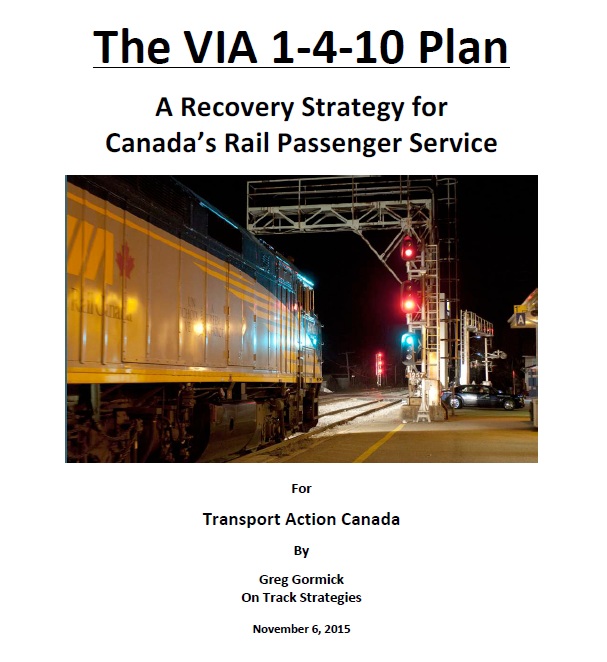The government of Prime Minister Justin Trudeau has been urged to undertake a sweeping review of passenger rail from coast to coast, and to initiate action to bring this country in step with the other nations in the G7 community. The challenge was unveiled two days after the new Liberal administration took office, at an event commemorating National Railway Day. It coincides with the 130th anniversary of the last spike ceremony that marked completion of a continuous rail link from across the country on November 7, 1885.
Transport Action Canada and its regional affiliates have just completed a comprehensive document entitled The VIA 1-4-10 Plan. Prepared by eminent transportation consultant and writer Greg Gormick, it explores the past, present and future of passenger rail, tracing its decline since the flawed creation of VIA Rail Canada by order-in-council in 1978, and offering practical and achievable suggestions for its reconstruction. A copy of the report has been delivered to Transport Minister Marc Garneau, with public release taking place during a Railway Day event at the VIA station in St. Mary’s, Ontario.
“The timing is doubly appropriate,” says Transport Action Atlantic president Ted Bartlett, “because a government that has embraced ‘real change’ is taking office so close to the anniversary of an event so significant to Canada’s very existence. We’re asking Minister Garneau to include this issue among his priorities.”
The VIA 1-4-10 Plan includes among its key recommendations that the new government appoint a highly-qualified Rail Passenger Action Force to advise the minister and to chart a firm course for the future. Essential to success, the consultant believes, is a long-overdue act of Parliament to establish a sound legislative foundation for VIA Rail Canada, to clearly define its mandate, make it accountable to parliamentarians, and give it specific rights in its relationships with freight railroads over whose tracks it must travel.
The document makes numerous suggestions for realistic and achievable objectives over one, four and ten-year time frames – hence its title. Among them, the return of VIA’s maritime train, the Ocean, to daily service is proposed as a reasonable first-year objective.
“A daily train is clearly what is needed to meet the very real transportation needs of Maritimers – especially those who live in northern New Brunswick,” Bartlett said. “It must always be remembered that these are Canadians who have few other public transportation options; for them the Ocean is very, very important. And VIA’s own published results show that they saved practically nothing when they reduced the service in 2012. Revenues and ridership dropped far more than costs, just as we had predicted.”
Greg Gormick quotes research conducted for Amtrak in the US that shows a daily train has a public cost just marginally higher that a tri-weekly one, but offers more than double the level of service, optimizes use of equipment and human resources, and offers the best potential to build and sustain ridership.
“We’re quite optimistic,” Bartlett concluded. “Minister Garneau was among the opposition members of the last Parliament who voted unanimously in favour of a private member’s VIA Rail bill that was ultimately defeated by the Conservative majority. We hope he will now move quickly, in the belief – to use the Prime Minister’s words – that ‘in Canada, better is always possible.’”
Read the full text of The VIA 1-4-10 Plan here.






